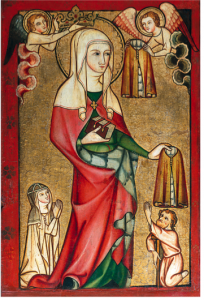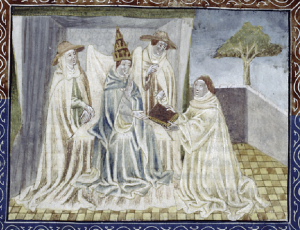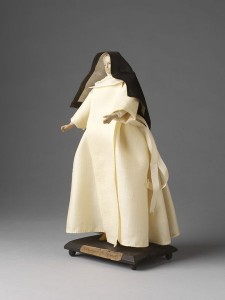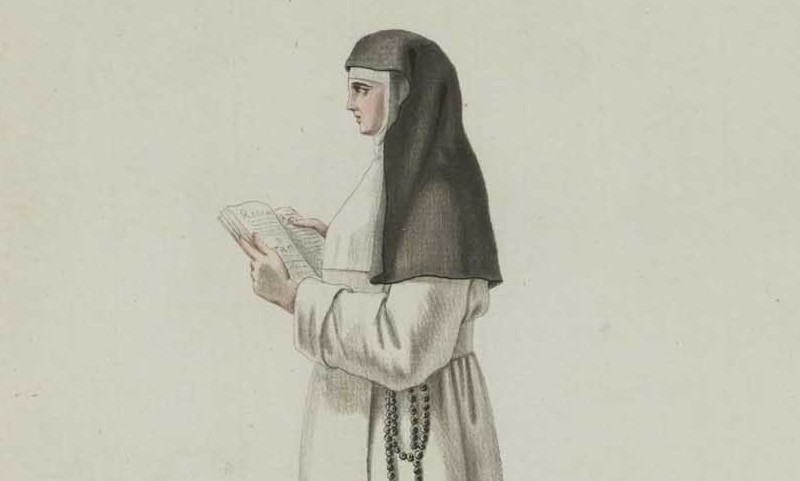Clothing mattered for medieval religious women—as it did for all women in the Middle Ages. It marked out rank, gender, and age, but it also made a statement about marital status and morality. Many of the Church Fathers such as Jerome, John Chrysostom and Tertullian, whose writings were highly influential on the development of Christianity in the Middle Ages, had condemned any kind of extravagance or display in women’s clothing, fearing that it might cause men to feel spiritually or sexually tempted. (This is the same underlying reasoning which we see, say, driving gendered differences in dress codes in U.S. public schools.) This isn’t to say that medieval women (or men, for that matter) didn’t follow fashion, or use their clothing to display their wealth. But for those women who chose to take religious vows of whatever kind, those patristic strictures had weight, and from a very early period, female Christian religious opted to wear plain and inexpensive clothing. The Rule of Caesarius of Arles, written in 512, was the first monastic rule in western Europe written exclusively for women. It required that nuns wear simple outfits of undyed woollen cloth.

However, the reformed religious orders that emerged in the twelfth and thirteenth centuries—including the order which I work on, the Premonstratensians—were much more specific than their predecessors when it came to issues of monastic dress. Their Rules detailed the kind of cloth to be used, its colour and cut, what kinds of accessories were permitted, and if there could be seasonal variation. Not only did these regulations help to set the virtuous vowed religious apart from the world, but they also helped to rein in some of the excesses of the more zealous members of the order. For instance, one of the order’s founders, Norbert of Xanten, was reputed to have wandered barefoot as a preacher through the snows of northern France and the Rhineland while clad only in the skins of sheep and goats—a clear attempt to mimic John the Baptist’s voice crying out in the wilderness (allowing for the fact that camel skin was not so easy to come by in twelfth-century northwestern Europe). This kind of ostentatious piety was enough to attract censure from the Council of Fritzlar. [MGH Scriptores XII: 673].
As you can see from the early fourteenth-century Altenberg altarpiece pictured left—one of the few contemporary visual sources for what medieval Premonstratensian sisters dressed like—they were not any more covered-up than were their lay female counterparts. Nothing is visible of the body of either the kneeling sister or the standing noblewoman other than their face and hands. The basic shapes and items of clothing were also similar—the nun’s belted habit is like the laywoman’s belted tunic; both women wear a cloak over this, together with a veil and wimple (a piece of cloth that covers the throat and chest). We can’t see the women’s feet, but likely both are wearing shoes and perhaps even woollen hose for added warmth. What marks the clothing of the Premonstratensian sister out from the laywoman is the absence of colour and ornamentation, together with much less elaborate drapery and folding of the fabric. The noblewoman’s clothing is designed to make you notice how much she has; the Premonstratensian sister’s, how much she has given up.
From early in the history of the Premonstratensian Order, donning the habit was considered a necessary step for admission to its ranks. In a letter written around 1160, Philippe, abbot of the Cistercian house of L’Aumône, discussed a niece of his who had impulsively decided to join the Premonstratensians. (Very impulsively: she hadn’t stopped to ask permission from the order itself.) However, Philippe seemed to think that his niece’s actions—taking a vow of virginity in front of an altar, cutting off her hair, and putting on the habit—irrefutably made her a Premonstratensian. [Text]
What that habit looked like was decided by the order’s General Chapter—the assembly of the Premonstratensians’ leaders which met, at least in theory, on a regular basis. Like the Cistercians, Gilbertines, and Carthusians, Premonstratensian men and women wore mostly white habits—likely because of the colour’s association with purity—but the details did change over the course of the Middle Ages.

One of the earliest commentators on the Premonstratensians, the monk-chronicler Herman of Tournai (ca. 1090-1147), said that the order’s sisters could wear only a single garment made of wool or sheepskin, with a veil made of cheap black cloth [Patrologia Latina 156, col. 996]. However, the earliest known statutes of the order (ca. 1135) present a slightly more complicated picture. In the summer, the sisters wore white linen tunics with black linen veils; in the winter, they wore tunics and veils made of black linen or coarse, itchy black wool. (“Black wool” probably meant wool that was dark in colour, because it was difficult and expensive to dye wool a pure black with the technology available at the time.) At all times of the year, they could wear a belt from which hung a small knife in a sheath. [BSM Clm. 17174, ff.38v-39]
These regulations were modified around 1200—new statutes stated that under pain of excommunication, Premonstratensian sisters were never to wear black tunics, only white tunics and black surplices (a kind of loose over-tunic). [BM Troyes MS 802, ff. 93-94] Mid-thirteenth statutes modified the required habit of Premonstratensian women yet again: the sisters were to wear all-white clothing, except in the regions where it had been customary (ex antiqua consuetudine) that they wear different-coloured tunics. It’s not clear why all these legislative changes were made—perhaps the Premonstratensians were trying to more effectively distinguish themselves from other orders—but they clearly faced regional push-back from women who valued the traditions of their particular communities. The habit of a Premonstratensian sister signified individual religious purity, but it also signalled a group identity.
As the push-back makes clear, just because the Premonstratensian Order—and indeed the Church hierarchy—told women they had to dress in a particular way doesn’t mean that they were listened to. The Council of Reims (1157) forbade religious women from wearing habits made of sumptuous fabrics [Text]—but 150 years later, the Council of Vienne (1311-12) felt the need to reiterate that nuns shouldn’t wear silk gowns, fur trims, sandals, elaborate hairstyles, or plaid or striped veils. [Text] These councils would have had no reason to ban these kinds of attire if there hadn’t been religious women sporting them—and the fact that many church councils issued legislation like this over and over means that their rules weren’t always observed. Nunneries in the Middle Ages may have been far more colourful places than we give them credit for.

Until the changes introduced by Vatican II in the mid-twentieth century, Catholic sisters and nuns largely dressed as had their medieval foremothers. Even by the early nineteenth-century, however, nuns’ habits had long since ceased to be an austere variant on everyday women’s variant and had become something distinctly associated with religious women. The hemp-and-wax Premonstratensian doll (pictured at left) was made in the first half of the nineteenth century, perhaps as an educational aid to help distinguish between various religious orders and congregations. Enclosed orders still wear the traditional habits (as indeed do modern Premonstratensian canonesses, like those who recently establish a community at Tehachapi in California), but members of nursing and teaching congregations—the kinds of female religious whom the general public are most likely to encounter—now largely wear contemporary, albeit modest, clothing. The choice to don or discard the habit, now as in the Middle Ages, is a powerful and immediate way of communicating how a religious woman—and the community which she inhabits—understands her religious faith.
Read More:
Pierre Hélyot. Dictionnaire des ordres religieux (Paris, 1714-19). [Archive.org]
Adrien Schoonenbeek. Courte description des ordres des femmes & filles religieuses (Amsterdam, 1691). [Archive.org]
Collection of 19th century dolls representing Catholic religious orders. [Victoria and Albert Museum]

Great post, Yvonne!
You confirmed the information told to me by the sisters at the Bar Convent about the dress of their 17th-century predecessors. For them, the ability to “blend in” by dressing much like their secular counterparts was crucial to their ability to accomplish their mission in England — they needed to remain inconspicuous to survive in a time when being Catholic could land you in prison. Consequently, the women developed an image as “respectable matrons” rather than members of a religious order.
On a similar point, the students at the Br Convent were required to wear school uniforms beginning about 1790, immediately after the French Revolution, which coincided with the arrival of a new “French” superioress!
Thank you so much, Kathy!
That’s fascinating about the women at the Bar Convent—everything you’ve told me about them makes me doubly impressed that they were able to fly under the radar for as long as they did. Did they need some sort of dispensation in order to wear secular clothes? I presume they resumed the habit after Emancipation. And I wonder about the links between the uniform for girls and the habit for nuns and what went into the “design” of the former. The convent school I attended was founded in 1809 and this is an advert for it that was placed in the 1840s in the Catholic press—the girls were clearly wearing uniforms but sadly no description of it is given.